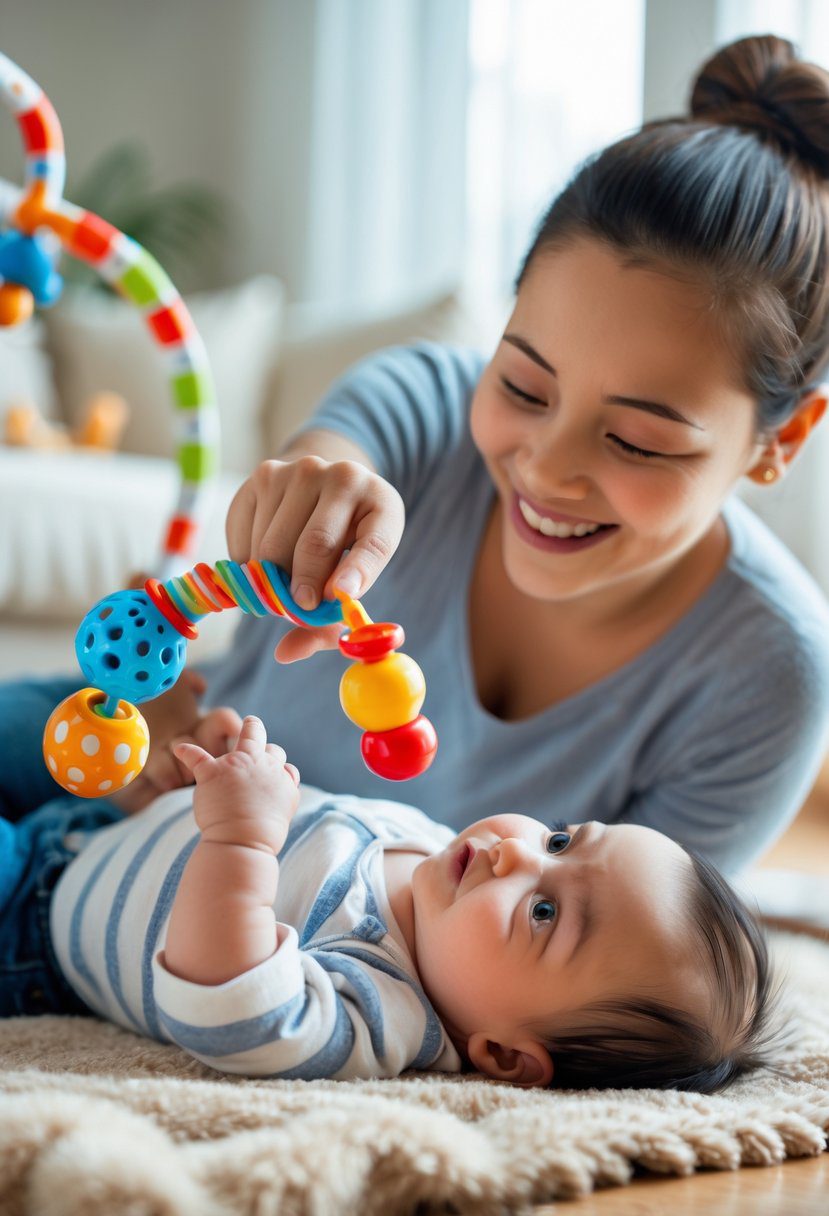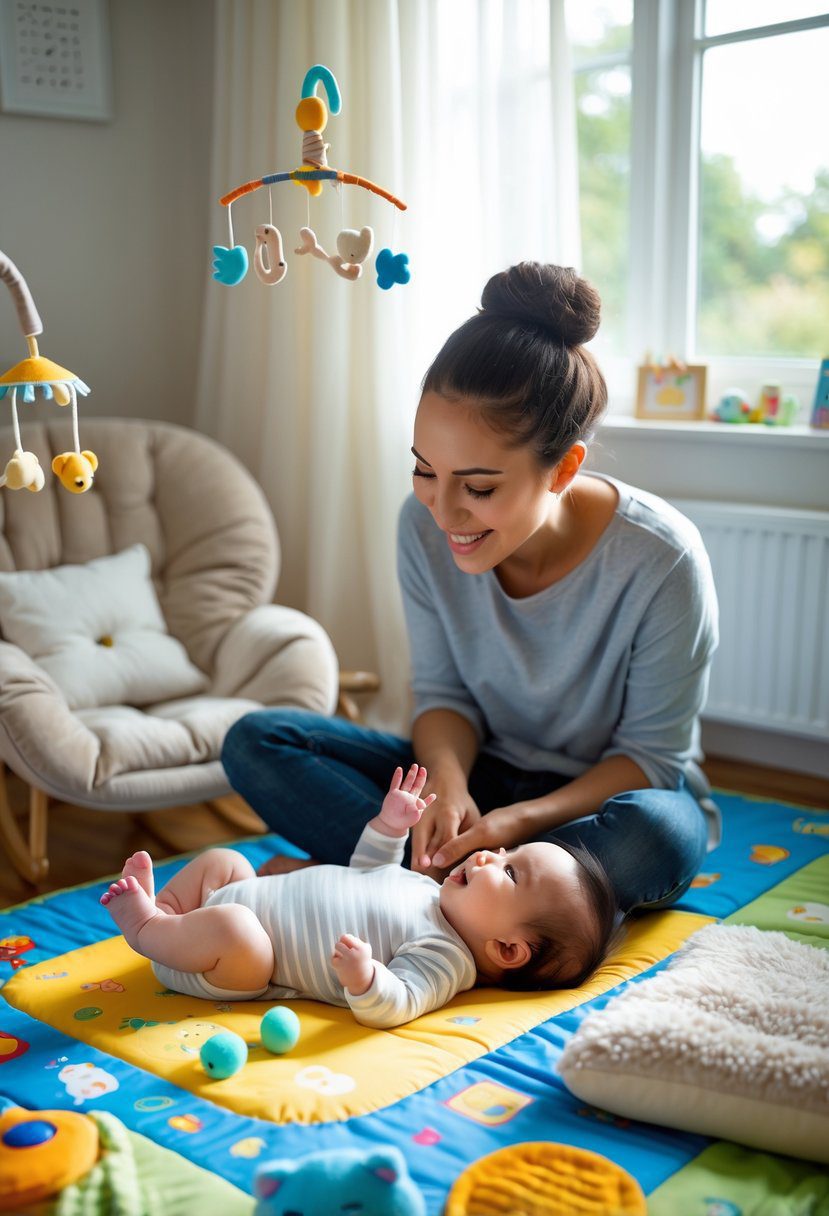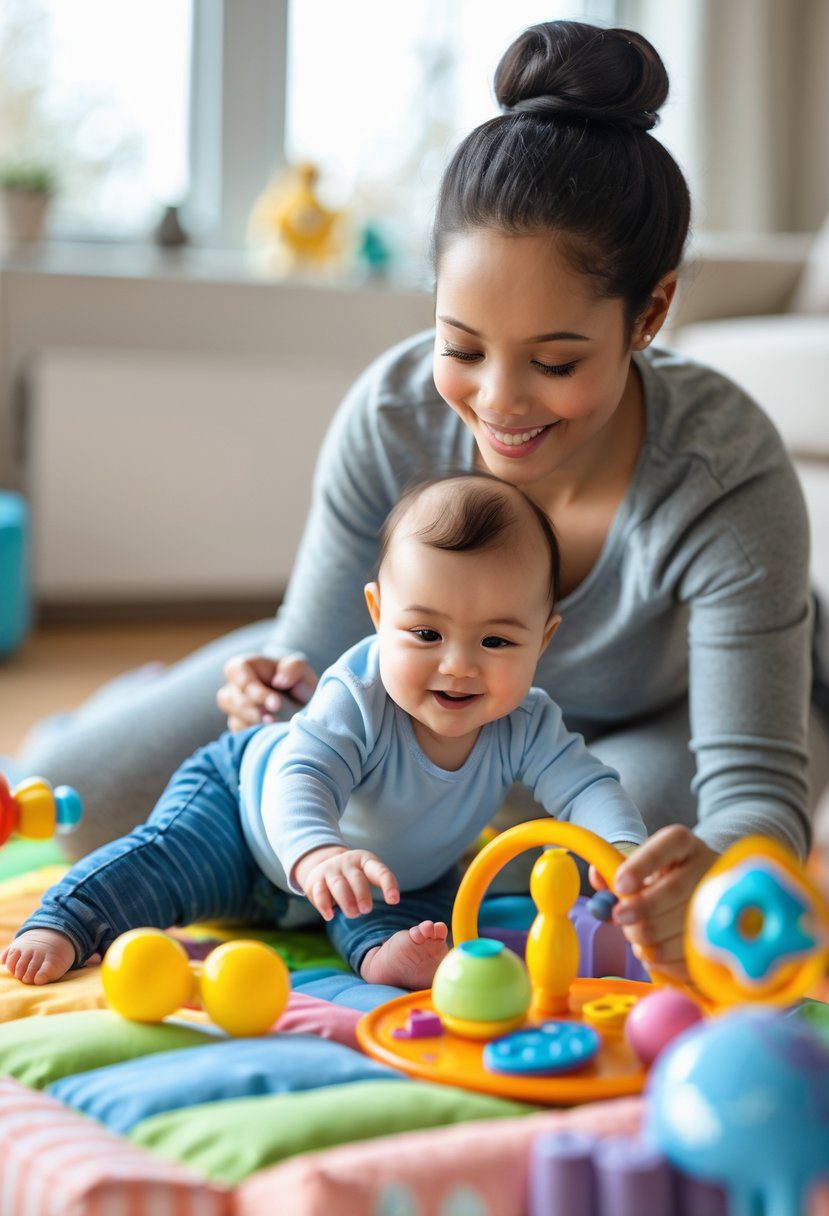
Spending time with an infant during their first six months is important for their growth and development. Engaging in simple activities helps build their motor skills, sensory awareness, and bonding with caregivers.
The key is to choose activities that support both physical and emotional development in a safe and loving way. These early interactions can lay a strong foundation for future learning and connection.
1) Tummy Time on a Soft Blanket

Tummy time helps babies build neck and shoulder muscles. Using a soft blanket makes the activity more comfortable for the infant.
It is best to start with just a few minutes at a time. Gradually increase tummy time to 10-15 minutes, two or three times a day.
A soft playmat or blanket on the floor supports the baby’s body and encourages movement tummy time activities.
2) Face your baby and make eye contact

Making eye contact with a baby helps build a connection. It allows the baby to learn about emotions and nonverbal communication.
When the baby makes sounds, responding with smiles and gentle talk encourages them to keep trying to communicate.
This simple activity supports early social skills and helps the baby feel seen and secure. For tips on eye contact and interaction, see activities for newborns and infants.
3) Sing nursery rhymes together

Singing nursery rhymes helps babies hear different sounds and rhythms. It supports early language skills by exposing them to simple words and patterns.
Caregivers can choose easy, familiar songs to make singing fun and engaging. Repeating rhymes helps babies recognize sounds and words over time.
Using songs with actions, like clapping or tapping, can keep babies interested. Singing together also creates a calm and loving connection.
For more ideas, try songs suited for babies 0-6 months old from this interactive songs list.
4) Take leisurely stroller walks

Taking a baby for a slow walk in a stroller is a great way to spend time outside. The baby can see new sights and hear different sounds, which helps with learning.
It is important to choose a safe and quiet area. Parents can point out things like trees, birds, or cars to engage their infant.
These walks also give the parent a chance to relax while keeping the baby calm and comfortable. For more ideas, see activities to do with infants during walks.
5) Play simple water games with balls
They can fill a small basin or play pool with water and add lightweight balls. This helps babies explore different textures and movements.
Babies can watch the balls float or gently push them around. It encourages hand-eye coordination and sensory learning.
Using balls in water is safe and easy to set up at home. This activity is recommended for infants to enjoy simple water play with toys.
More ideas can be found in simple water play with balls activities.
6) Read picture books aloud

Reading picture books aloud helps babies hear different sounds and words. It supports their early language skills and builds familiarity with books.
Simple books with bright images catch their attention and encourage focus. Talking about the pictures also helps babies connect words to objects.
Parents can choose board books designed for infants, which are easy to hold and safe to explore. Regular reading sessions help create a calm and bonding time for both.
For more ideas on reading with babies, see 12 favorite read alouds for babies & toddlers.
7) Imitate your baby’s facial expressions

Parents can watch their baby’s face closely and copy their movements. If the baby smiles or frowns, the parent can do the same. This helps the baby feel understood and builds early communication skills.
Using big, clear facial expressions makes it easier for the baby to notice and copy. This simple activity supports emotional bonding and encourages social interaction from a young age.
For more ideas, see imitation activities for infants and toddlers.
8) Use a rattle to encourage tracking

Using a rattle helps babies follow objects with their eyes. When an adult moves the rattle side to side, the baby practices tracking the movement.
This activity supports visual development and attention. It also encourages reaching as babies try to grasp the rattle.
Rattles with easy grips and different sounds work best. More tips on using rattles for infant development are available at activities for babies (0-18 months).
9) Talk and respond to baby’s babbles

It is important to talk to the baby often. When the baby makes sounds, responding helps them learn how conversations work.
Caregivers should listen carefully and take turns “talking” with the baby. This back-and-forth helps develop early communication skills.
Using a high-pitched, sing-song voice can keep the baby engaged. Smiling and making eye contact while responding also supports language growth.
This simple interaction encourages the baby to practice making sounds and builds a foundation for speaking later on. For more tips, see talking play ideas for babies.
10) Blow raspberries to make them smile

Blowing raspberries on a baby’s skin is an easy way to get their attention. Pressing lips gently on their tummy and blowing air creates a funny sound and feeling.
This often makes babies smile or giggle. It can also help start early communication skills. Parents use this playful action to calm or entertain their infant during diaper changes or quiet moments.
Blowing raspberries is a simple, sensory activity recommended for infants between 0-6 months to encourage interaction and bonding.
For more ideas, see blowing raspberries activities for babies.
The Importance of Early Bonding

Early bonding sets the foundation for a baby’s emotional security and social skills. It helps babies feel safe and understood while encouraging healthy brain development.
Building Emotional Connections
Emotional connections begin with simple acts like skin-to-skin contact, gentle touch, and responsive caregiving. When a caregiver consistently meets a baby’s needs, the baby learns to trust and feel secure.
This trust supports the release of calming hormones in both baby and caregiver. It also helps regulate the baby’s emotions and stress levels. Over time, these positive feelings form a strong bond that guides healthy emotional growth.
Caregivers can strengthen this bond by making eye contact, smiling, and talking softly. These actions reassure the baby and promote feelings of love and safety.
Encouraging Social Development
Early bonding plays a key role in social development. Babies learn to read facial expressions, recognize voices, and respond to cues. These are the building blocks for communication and social interaction.
Engaging with a baby through play, such as making silly faces or gentle talking, helps develop their social skills. Babies begin to anticipate responses and enjoy back-and-forth interactions.
Regular close connection also prepares babies to form healthy relationships later in life. It teaches them how to trust others and express their needs.
More activities that support bonding and development can be found at 10 Effective Newborn Baby Bonding Activities.
Supporting Sensory and Motor Development

Infants need opportunities to explore textures, sounds, and movements safely. Watching for key skills helps adults support growth at the right time.
Creating a Safe Environment
Infants learn best in spaces free from hazards. Soft mats or blankets provide a gentle place for tummy time and reaching for toys. Sharp corners, small objects, and loose cords should be kept out of reach.
Toys for this age should be lightweight, easy to grip, and non-toxic. Rattles and soft books with different textures help babies practice holding and shaking. Bright colors and simple patterns keep their attention without overwhelming them.
Adults must supervise closely during sensory activities. Keeping the area clean and calm reduces distractions and allows infants to focus on new sensations safely.
Recognizing Developmental Milestones
Caregivers should notice when babies start lifting their heads during tummy time or grasping toys. These actions show motor skills are developing.
Babies between 0-6 months often begin to track objects with their eyes and respond to sounds. If an infant struggles to focus or move their limbs, caregivers might consult a pediatrician.
Tracking milestones like smiling, cooing, or reaching improves understanding of sensory progress. Parents can encourage development by offering varied textures and gentle movements during play to support these skills.
Toys and activities that match the baby’s stage help build strength and sensory awareness step-by-step.



